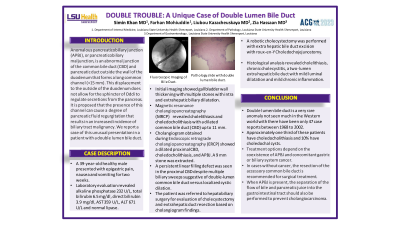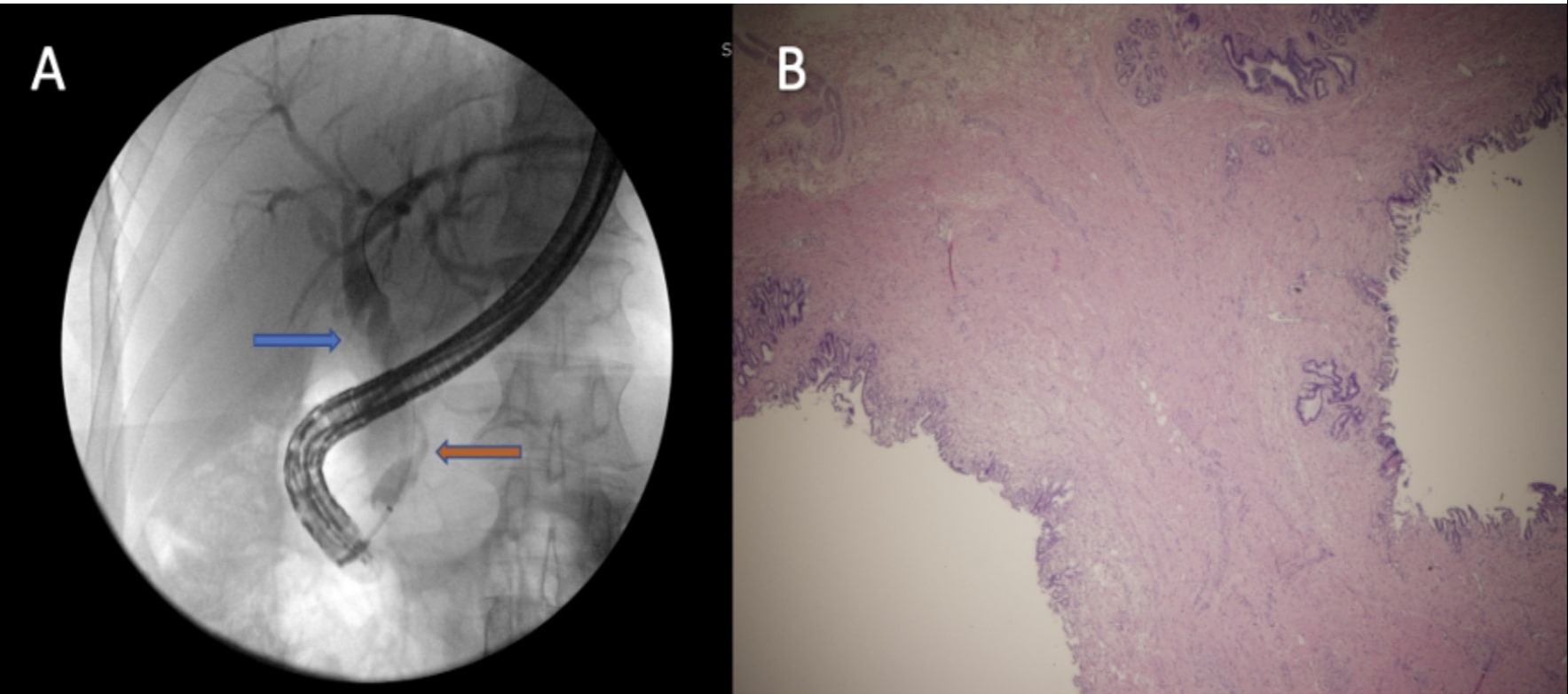Tuesday Poster Session
Category: Biliary/Pancreas
P2959 - Double Trouble: A Unique Case of Double Lumen Bile Duct
Tuesday, October 24, 2023
10:30 AM - 4:00 PM PT
Location: Exhibit Hall

Has Audio

Simin Khan, MD
Louisiana State University Health
Shreveport, LA
Presenting Author(s)
Simin Khan, MD1, Farhan Mohiuddin, 1, Liubou Kazacheuskaya, MD1, Hassaan A. Zia, MD2
1Louisiana State University Health, Shreveport, LA; 2LSU Health Sciences Center, Shreveport, LA
Introduction: Anomalous pancreaticobiliary junction (ABPJ) is an abnormal junction of the common bile duct (CBD) and pancreatic duct outside the wall of the duodenum that forms a long common channel (< 15 mm). This abnormal junction can influence the degree of pancreatic fluid reflux, resulting in an increased incidence of biliary tract malignancy. We present one such interesting case of a patient with ABPJ and double lumen common bile duct.
Case Description/Methods: A 39-year-old healthy male presented with epigastric pain, nausea and vomiting for two weeks. Laboratory evaluation revealed alkaline phosphatase 232 U/L, total bilirubin 6.5 mg/dl, direct bilirubin 3.9 mg/dl, AST 359 U/L, ALT 671 U/L and normal lipase. Initial imaging showed gallbladder wall thickening with multiple stones with intra and extrahepatic biliary dilatation. Magnetic resonance cholangiopancreatography (MRCP) revealed cholelithiasis and choledocholithiasis with a dilated common bile duct (CBD) up to 11 mm.
Cholangiogram obtained during Endoscopic retrograde cholangiopancreatography (ERCP) showed a dilated proximal CBD, choledocholithiasis and APBJ. A 9 mm stone was extracted. A persistent linear filling defect was seen in the proximal CBD despite multiple biliary sweeps suggestive of double lumen common bile duct versus localized cystic dilation. Patient was referred to hepatobiliary surgery for evaluation of cholecystectomy and extrahepatic duct resection based on cholangiogram findings. A robotic cholecystectomy was performed with extra hepatic bile duct excision with roux-en-Y choledochojejunostomy.
Histological analysis revealed cholelithiasis, chronic cholecystitis, a two-lumen extra hepatic bile duct with mild luminal dilatation and mild chronic inflammation.
Discussion: Double lumen bile duct is a very rare anomaly not seen much in the Western world with there have been only 47 case reports between 1968 to 2002. Approximately one third of these patients have choledocholithiasis and 10% have choledochal cysts. Treatment options depend on the coexistence of APBJ and concomitant gastric or biliary system cancer. In cases without cancer, the resection of the accessory common bile duct is recommended for surgical treatment. When APBJ is present, the separation of the flow of bile and pancreatic juice into the gastrointestinal tract should also be performed to prevent cholangiocarcinoma.

Disclosures:
Simin Khan, MD1, Farhan Mohiuddin, 1, Liubou Kazacheuskaya, MD1, Hassaan A. Zia, MD2. P2959 - Double Trouble: A Unique Case of Double Lumen Bile Duct, ACG 2023 Annual Scientific Meeting Abstracts. Vancouver, BC, Canada: American College of Gastroenterology.
1Louisiana State University Health, Shreveport, LA; 2LSU Health Sciences Center, Shreveport, LA
Introduction: Anomalous pancreaticobiliary junction (ABPJ) is an abnormal junction of the common bile duct (CBD) and pancreatic duct outside the wall of the duodenum that forms a long common channel (< 15 mm). This abnormal junction can influence the degree of pancreatic fluid reflux, resulting in an increased incidence of biliary tract malignancy. We present one such interesting case of a patient with ABPJ and double lumen common bile duct.
Case Description/Methods: A 39-year-old healthy male presented with epigastric pain, nausea and vomiting for two weeks. Laboratory evaluation revealed alkaline phosphatase 232 U/L, total bilirubin 6.5 mg/dl, direct bilirubin 3.9 mg/dl, AST 359 U/L, ALT 671 U/L and normal lipase. Initial imaging showed gallbladder wall thickening with multiple stones with intra and extrahepatic biliary dilatation. Magnetic resonance cholangiopancreatography (MRCP) revealed cholelithiasis and choledocholithiasis with a dilated common bile duct (CBD) up to 11 mm.
Cholangiogram obtained during Endoscopic retrograde cholangiopancreatography (ERCP) showed a dilated proximal CBD, choledocholithiasis and APBJ. A 9 mm stone was extracted. A persistent linear filling defect was seen in the proximal CBD despite multiple biliary sweeps suggestive of double lumen common bile duct versus localized cystic dilation. Patient was referred to hepatobiliary surgery for evaluation of cholecystectomy and extrahepatic duct resection based on cholangiogram findings. A robotic cholecystectomy was performed with extra hepatic bile duct excision with roux-en-Y choledochojejunostomy.
Histological analysis revealed cholelithiasis, chronic cholecystitis, a two-lumen extra hepatic bile duct with mild luminal dilatation and mild chronic inflammation.
Discussion: Double lumen bile duct is a very rare anomaly not seen much in the Western world with there have been only 47 case reports between 1968 to 2002. Approximately one third of these patients have choledocholithiasis and 10% have choledochal cysts. Treatment options depend on the coexistence of APBJ and concomitant gastric or biliary system cancer. In cases without cancer, the resection of the accessory common bile duct is recommended for surgical treatment. When APBJ is present, the separation of the flow of bile and pancreatic juice into the gastrointestinal tract should also be performed to prevent cholangiocarcinoma.

Figure: Figure 1: Image A indicating an endoscopic retrograde cholangiopancreatography (ERCP) where a double-lumen bile duct (blue arrow) and an anomalous pancreaticobiliary junction (ABPJ) (brown arrow) are shown. Image B is shown representing the histology slide of the double-lumen bile duct.
Disclosures:
Simin Khan indicated no relevant financial relationships.
Farhan Mohiuddin indicated no relevant financial relationships.
Liubou Kazacheuskaya indicated no relevant financial relationships.
Hassaan A. Zia indicated no relevant financial relationships.
Simin Khan, MD1, Farhan Mohiuddin, 1, Liubou Kazacheuskaya, MD1, Hassaan A. Zia, MD2. P2959 - Double Trouble: A Unique Case of Double Lumen Bile Duct, ACG 2023 Annual Scientific Meeting Abstracts. Vancouver, BC, Canada: American College of Gastroenterology.
